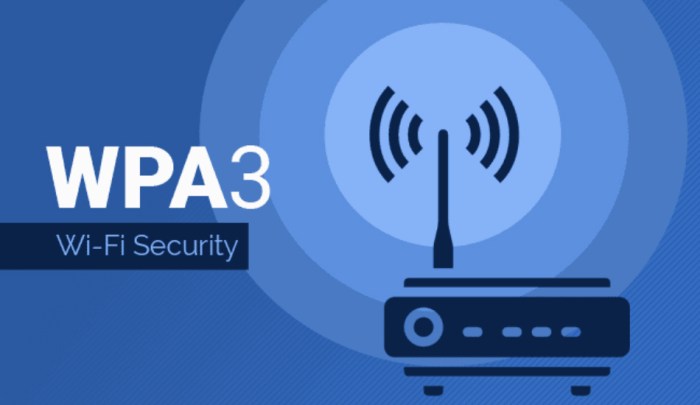Introduction to WPA3
WPA3 is the latest generation of Wi-Fi security protocols designed to enhance the protection of wireless networks and combat evolving cyber threats. It’s a significant advancement over its predecessor, WPA2, offering robust security features and improved protection against modern hacking techniques.
WPA3 is the natural evolution of WPA2, addressing vulnerabilities and incorporating new security measures to ensure stronger protection for your wireless networks. The transition from WPA2 to WPA3 is essential for safeguarding your data and maintaining the integrity of your Wi-Fi network.
Key Features and Benefits of WPA3
WPA3 offers a range of advanced features and benefits that significantly enhance wireless security. Here’s a breakdown of its key aspects:
- Enhanced Encryption: WPA3 employs the latest encryption standard, WPA3-SAE (Simultaneous Authentication of Equals), which replaces the older WPA2-PSK (Pre-Shared Key) method. This new encryption method provides more robust protection against brute-force attacks, where hackers attempt to guess passwords by trying numerous combinations.
- Improved Password Strength: WPA3 enforces stronger password requirements, making it harder for attackers to crack passwords. The protocol requires longer and more complex passwords, minimizing the risk of unauthorized access.
- Enhanced Authentication: WPA3 features a more robust authentication process, ensuring that only authorized devices can connect to the network. It utilizes a more sophisticated authentication scheme, making it more difficult for attackers to impersonate legitimate devices.
- Increased Security for Public Wi-Fi: WPA3 provides enhanced security for public Wi-Fi networks, such as those found in cafes, airports, and hotels. This is particularly important as public Wi-Fi networks are often more vulnerable to security breaches.
- Support for Modern Devices: WPA3 is compatible with modern Wi-Fi devices, ensuring that users can take advantage of its advanced security features.
WPA3 Security Enhancements
WPA3 is a significant leap forward in Wi-Fi security, offering enhanced protection against various threats. It incorporates several security enhancements, including the implementation of Simultaneous Authentication of Equals (SAE), which strengthens password protection and enhances resistance to dictionary attacks and brute-force attempts. WPA3 also plays a crucial role in preventing man-in-the-middle attacks and eavesdropping, ensuring secure communication on Wi-Fi networks.
Simultaneous Authentication of Equals (SAE), Wifi alliance new secure wpa3 standard
SAE, also known as Dragonfly, is a revolutionary authentication protocol that replaces the traditional Pre-Shared Key (PSK) method used in WPA2. SAE leverages a secure handshake process involving both the client and the access point, making it significantly more resilient against attacks.
SAE is designed to be more robust against dictionary attacks and brute-force attempts. It uses a combination of cryptography and password hashing techniques to protect passwords and prevent unauthorized access.
Enhanced Protection Against Dictionary Attacks and Brute-Force Attempts
Dictionary attacks involve using a list of common passwords to guess the correct one. Brute-force attacks involve systematically trying every possible combination of characters until the correct password is found. SAE significantly enhances security by:
- Using a more robust password hashing algorithm: SAE employs a stronger hashing algorithm, making it significantly harder for attackers to crack passwords.
- Introducing a “slow” authentication process: SAE intentionally slows down the authentication process, making it significantly harder for attackers to perform brute-force attacks.
- Employing a “fast fail” mechanism: If an attacker attempts multiple incorrect passwords, the access point will quickly block the attacker, preventing further attempts.
Preventing Man-in-the-Middle Attacks and Eavesdropping
Man-in-the-middle attacks occur when an attacker intercepts communication between a client and an access point. This allows the attacker to eavesdrop on the communication, steal sensitive information, or even inject malicious data. WPA3 effectively mitigates these attacks by:
- Implementing strong encryption: WPA3 utilizes advanced encryption algorithms, making it significantly harder for attackers to decrypt data.
- Enforcing data integrity: WPA3 ensures that data transmitted over the Wi-Fi network remains intact and hasn’t been tampered with.
- Using secure key management: WPA3 employs a robust key management system, ensuring that only authorized devices can access the network.
WPA3 Features and Capabilities: Wifi Alliance New Secure Wpa3 Standard
WPA3, the latest Wi-Fi security standard, introduces a range of features and capabilities designed to enhance data security, improve network performance, and enable new Wi-Fi applications. These advancements ensure a more robust and secure wireless experience for users.
Enhanced Data Security with 192-bit Encryption
WPA3 significantly enhances data security by implementing 192-bit encryption, a substantial leap from the 128-bit encryption used in WPA2. This increased encryption strength makes it exponentially harder for attackers to decipher transmitted data, providing a much more secure connection for sensitive information. This stronger encryption is crucial for protecting data in environments where security is paramount, such as financial transactions, healthcare records, and confidential business communications.
Improved Network Speed and Performance
WPA3 doesn’t just focus on security; it also contributes to improved network performance. The new standard incorporates optimizations that can lead to faster network speeds and smoother data transmission. These improvements are achieved through various mechanisms, including:
* Optimized Handshake Process: The process of establishing a secure connection between devices and the Wi-Fi network is streamlined, reducing latency and improving overall performance.
* Enhanced Data Transmission Efficiency: WPA3 utilizes more efficient data transmission techniques, leading to faster data transfer rates and a more responsive user experience.
* Improved Network Stability: The enhanced security measures in WPA3 contribute to a more stable network connection, reducing the likelihood of dropped connections and improving the overall user experience.
Enabling New Wi-Fi Features and Applications
The advanced security and performance capabilities of WPA3 pave the way for new Wi-Fi features and applications. These include:
* Enhanced IoT Security: The robust security features of WPA3 make it ideal for securing Internet of Things (IoT) devices, which are increasingly becoming a target for cyberattacks.
* Next-Generation Wi-Fi Networks: WPA3 lays the foundation for future Wi-Fi networks, enabling the development of advanced features like seamless roaming, increased capacity, and improved power efficiency.
* New Wi-Fi Applications: WPA3’s enhanced capabilities can enable the development of innovative Wi-Fi applications that leverage its security and performance improvements.
The Future of Wi-Fi Security
WPA3 is a significant leap forward in Wi-Fi security, ushering in a new era of robust protection against modern cyber threats. Its advanced features, such as enhanced authentication, stronger encryption, and protection against brute-force attacks, are poised to significantly impact the future of wireless security.
Impact of WPA3 on Wireless Security
WPA3’s impact on wireless security is multifaceted and profound. It introduces a new level of protection, making it more challenging for attackers to compromise Wi-Fi networks. This is achieved through:
- Enhanced Authentication: WPA3 employs a more secure authentication protocol, making it harder for attackers to gain unauthorized access to networks. This is especially crucial in public Wi-Fi settings, where security vulnerabilities are more prevalent.
- Stronger Encryption: WPA3 uses the latest encryption algorithms, offering significantly stronger protection against eavesdropping and data interception. This ensures that even if attackers manage to gain access to the network, they won’t be able to decrypt the transmitted data.
- Protection Against Brute-Force Attacks: WPA3 incorporates mechanisms that prevent attackers from repeatedly guessing passwords to gain access. This significantly reduces the risk of brute-force attacks, a common method used to compromise Wi-Fi networks.
Emerging Trends and Technologies
The evolution of Wi-Fi security is continuously influenced by emerging trends and technologies. Some key areas to watch include:
- AI-Powered Security: Artificial intelligence (AI) is increasingly being used to enhance Wi-Fi security. AI algorithms can detect and prevent anomalies in network traffic, identify suspicious activity, and proactively adapt to evolving threats.
- Internet of Things (IoT) Security: The growing number of connected devices in the IoT presents new security challenges. Future Wi-Fi security standards will need to address the unique vulnerabilities of IoT devices and ensure secure communication between them.
- Quantum Computing: The development of quantum computing poses a potential threat to current encryption methods. Future Wi-Fi security standards will need to incorporate quantum-resistant algorithms to ensure continued protection against future attacks.
Challenges and Opportunities of Widespread Adoption
While WPA3 offers significant security improvements, its widespread adoption faces certain challenges and opportunities:
- Compatibility: Older devices may not be compatible with WPA3, requiring users to upgrade their hardware or software to benefit from the enhanced security. This could create a barrier to adoption, particularly for users with legacy equipment.
- Implementation Complexity: Implementing WPA3 can be complex, requiring technical expertise and careful configuration to ensure optimal security. This could pose a challenge for smaller businesses and home users who lack the necessary technical skills.
- Cost: Upgrading to WPA3-compatible devices or software can involve costs, which may deter some users from adopting the new standard. However, the long-term benefits of enhanced security outweigh the initial investment.
- Public Awareness: Raising public awareness about the importance of WPA3 and its benefits is crucial for widespread adoption. Education campaigns and clear communication can help users understand the value of upgrading their Wi-Fi security.
Wifi alliance new secure wpa3 standard – WPA3 isn’t just about making your Wi-Fi network more secure; it’s about paving the way for a future where technology empowers us without compromising our privacy. As we continue to rely on Wi-Fi for everything from streaming movies to managing our finances, WPA3 provides the peace of mind we need to navigate the digital landscape with confidence. So, the next time you connect to a Wi-Fi network, remember that WPA3 is working behind the scenes to keep your data safe and your online experience secure.
The WiFi Alliance’s new WPA3 standard is a game-changer for wireless security, offering stronger encryption and more robust protection against attacks. If you’re looking for a device that supports this cutting-edge security feature, check out the Galaxy X support page on the Samsung website here to see if it’s compatible. With WPA3, you can rest assured that your data is safe and secure, even on public networks.
 Standi Techno News
Standi Techno News

